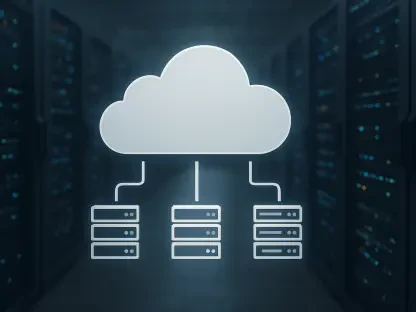The increasing global reliance on cloud computing has illuminated the urgent need to confront the environmental impact of data centers. These digital infrastructures are notorious for their substantial energy consumption, often exacerbated by inefficient practices and reliance on non-renewable energy sources. In response, tech giants are spearheading a significant transformation towards carbon-neutral cloud operations, aiming to balance technological advancement with environmental stewardship.
Environmental Initiatives and Goals
Google’s Commitment to Renewable Energy
Google has emerged as a leading force in the drive towards sustainable data centers. Since adopting 100% renewable energy to power its data centers, Google has been at the forefront of green technology innovation. The company continually seeks to enhance energy efficiency through advanced methodologies, including the implementation of cutting-edge cooling systems and the design of smarter, more sustainable servers. Google’s ambitious target of achieving carbon-free operations by 2030 underscores a long-term commitment to environmental responsibility that challenges both industry standards and the company’s own practices.
In pursuit of carbon neutrality, Google relies on diverse renewable energy sources such as wind, solar, and hydroelectric power. This approach mitigates the carbon footprint associated with massive data processing and storage. Complementing these efforts, the company engages in carbon offset initiatives like afforestation projects, which aim to balance unavoidable emissions. Despite these strides, environmental experts stress the importance of transparent reporting and third-party verification to validate carbon-neutral claims. Google’s journey exemplifies the intricate balance between ecological sensitivity and technological innovation.
Microsoft’s Carbon-Negative Vision
Microsoft’s pledge to become carbon-negative by 2030 represents one of the tech industry’s most ambitious environmental commitments. This initiative involves a comprehensive strategy encompassing not only renewable energy adoption but also sophisticated carbon capture and removal technologies. Microsoft’s roadmap to achieving carbon negativity links directly to its broader sustainability goals, including aggressive reductions in energy consumption and investments in renewable energy infrastructure.
A pivotal aspect of Microsoft’s strategy lies in its investment in modern cooling systems like liquid cooling. These systems offer significant environmental benefits by reducing energy and water usage compared to traditional air-based cooling methods. Furthermore, Microsoft continually explores software optimizations that enhance operational efficiency and minimize resource consumption. Microsoft’s approach merges innovative thinking with tangible action, driving progress towards a sustainable future while addressing inherent challenges such as water usage in drought-prone regions.
Technological Advancements in Data Centers
Innovations in Cooling Systems
In the quest for greener data centers, innovation in cooling technologies has proven crucial. Traditional air-based cooling systems, while widespread, consume large amounts of energy and water, prompting the development of more efficient alternatives like liquid cooling and immersion cooling. These advanced cooling methods involve submerging servers in a non-conductive liquid or using liquid coolant directly, resulting in significant reductions in energy consumption and thermal waste.
These technologies not only enhance energy efficiency but also reduce the environmental impacts associated with data center operations. Investment in these systems reflects a broader industry trend towards sustainable infrastructure. However, the environmental benefits of innovative cooling methods must be balanced against potential challenges, such as managing water usage in areas where resources are scarce. As the tech sector strives for sustainability, ongoing research and development in cooling technologies promise to deliver solutions that support both operational and environmental goals.
Addressing E-Waste Management
Alongside advancements in cooling systems, managing electronic waste (e-waste) presents another critical challenge for data centers. The rapid pace of technological innovation often results in a shorter lifespan for hardware components, leading to substantial e-waste generation. Addressing this issue requires a multi-faceted approach, including designing longer-lasting components, promoting recycling, and implementing comprehensive e-waste management strategies.
Tech companies are increasingly investing in sustainable practices to mitigate the impact of e-waste. Initiatives such as refurbishing old equipment, recycling components, and supporting circular economy principles are gaining traction. Moreover, partnerships with regulatory bodies and environmental organizations aim to ensure responsible disposal and recycling of electronic waste. These collaborative efforts highlight the industry’s commitment to sustainability, reflecting an understanding that reducing e-waste is integral to achieving broader environmental goals.
Global Influence and Policy
India’s Role in the Green Data Center Movement
India’s emergence as a digital economy underscores the importance of sustainable practices in its data center sector. Recognizing the energy-intensive nature of data center operations, the Indian government has proposed policies aimed at promoting energy efficiency and sustainability. These initiatives include incentives for adopting renewable energy, regulatory frameworks to support green infrastructure, and investments in technological innovations that reduce environmental impact.
The government’s proactive stance is mirrored by Indian tech companies’ growing commitment to green practices. Collaboration with international organizations and adherence to global sustainability standards underpin efforts to build a resilient and eco-friendly digital infrastructure. As India navigates the complexities of its rapid digital transformation, its policies and industry actions serve as a model for other emerging economies striving for a balance between growth and environmental stewardship.
Convergence of Technology and Sustainability
The movement towards a clean cloud represents a convergence of technology and sustainability, reshaping the landscape of modern digital infrastructure. Corporate pledges, government regulations, increased consumer demand for transparency, and incentives for startups collectively drive a systemic change in how cloud services operate. Achieving sustainability in the cloud involves not only reducing emissions but also fundamentally altering the infrastructure that powers the internet.
This shift reflects a growing recognition that addressing environmental challenges is not only a technical obligation but also an ethical imperative. Ensuring clean cloud operations requires innovative thinking, collective effort, and continuous improvement. The increasing dependency on digital services amplifies the urgency of cleaning the cloud, making sustainability a focal point for tech companies and policymakers alike. As the movement gains momentum, it promises to transform the digital landscape, setting new standards for responsible and sustainable technology.
Looking Ahead
The growing global dependence on cloud computing has brought to light the urgent necessity to address the environmental impact of data centers. These digital infrastructures are well-known for their high energy use, which is frequently worsened by inefficient practices and dependence on non-renewable energy sources. This substantial energy consumption contributes significantly to carbon emissions, which pose a serious threat to our environment. In response to these challenges, leading tech companies are spearheading a major shift towards achieving carbon-neutral cloud operations. Their goal is to integrate technological advancement with responsible environmental management. By committing to renewable energy sources and enhancing overall energy efficiency, these companies aim to set a benchmark for sustainable practices in the industry. This transformation is pivotal as it seeks to ensure that the benefits of cloud computing do not come at an unsustainable environmental cost. Efforts like these are vital in balancing the rapid growth of technology with the urgent need for environmental preservation.









